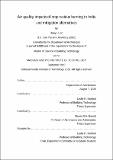Air quality impacts of crop residue burning in India and mitigation alternatives
Author(s)
Lan, Ruoyu, S.M. Massachusetts Institute of Technology.
Download1288582516-MIT.pdf (2.390Mb)
Other Contributors
Massachusetts Institute of Technology. Department of Architecture.
Advisor
Leslie K. Norford and Steven R.H. Barrett.
Terms of use
Metadata
Show full item recordAbstract
Crop residue burning is a leading contributor to air pollution and ill health in India. Despite current bans to curtail agricultural fires, burning persists because of a lack of alternatives that are both effective and politically viable. This thesis applies adjoint of the GEOS-Chem regional chemistry-transport model in combination with epidemiological and economic models to inform rational decision-making. First, this thesis estimates the premature deaths as 43,000-73,000 valued at 10-23 billion USD in India attributable to exposure to ambient fine particulate matter (PM2.5) from crop residue burning, and finds Punjab, Haryana, and Uttar Pradesh contribute the majority (83%-95%) over 2005-2016, with 35-40% of impacts occurring in densely populated areas downwind. Second, this thesis quantifies the sensitivity of net impacts to potential changes in space and time, suggesting that relatively significant air quality benefits across India could be achieved in southeast Punjab; promoting burning earlier in the morning in November in Punjab alone could prevent up to 8,700 (95% CI: 5,700-12,000) premature deaths annually, valued at 2.2 (95% CI: 0.22-7.0) million USD. Third, this thesis compares the cost and benefit of mitigation alternatives for both the public and private sectors. The findings support the use of targeted and potentially low-cost alternatives rather than bans.
Description
Thesis: S.M. in Building Technology, Massachusetts Institute of Technology, Department of Architecture, September, September, 2020 Cataloged from the official PDF of thesis. Includes bibliographical references (pages 49-55).
Date issued
2020Department
Massachusetts Institute of Technology. Department of ArchitecturePublisher
Massachusetts Institute of Technology
Keywords
Architecture.